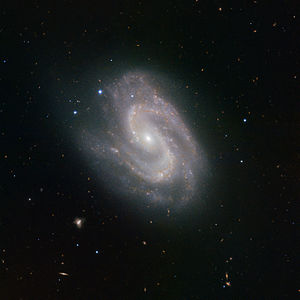NGC 157
| Galaxy NGC 157 |
|
|---|---|

|
|
| Infrared recording with the HAWK-I instrument | |
| AladinLite | |
| Constellation | whale |
|
Position equinox : J2000.0 , epoch : J2000.0 |
|
| Right ascension | 00 h 34 m 46.7 s |
| declination | -08 ° 23 ′ 47 ″ |
| Appearance | |
| Morphological type | SAB (rs) bc / HII |
| Brightness (visual) | 10.4 mag |
| Brightness (B-band) | 11.2 mag |
| Angular expansion | 3.5 ′ × 2.4 ′ |
| Position angle | 36 ° |
| Surface brightness | 12.6 mag / arcmin² |
| Physical data | |
| Redshift | 0.005510 ± 0.000017 |
| Radial velocity | (1652 ± 5) km / s |
|
Stroke distance v rad / H 0 |
(77 ± 5) · 10 6 ly (23.5 ± 1.6) Mpc |
| history | |
| discovery | Wilhelm Herschel |
| Discovery date | December 13, 1783 |
| Catalog names | |
| NGC 157 • PGC 2081 • MCG -02-020-56 • IRAS 00322-0840 • 2MASX J00344675-0823473 • GC 78 • H II 3 • HIPASS J0034-08 | |
NGC 157 is a bar-spiral galaxy with extensive star formation regions of the Hubble type SBbc in the constellation Whale south of the celestial equator . The galaxy is estimated to be 77 million light-years from the Milky Way and about 80,000 light years in diameter.
The type Ic supernova SN 2009em was observed here.
The object was discovered by Wilhelm Herschel on December 13, 1783 .
Web links
Commons : NGC 157 - collection of images, videos, and audio files
- SIMBAD Astronomical Database
- Spektrum.de : Amateur recordings [1]
